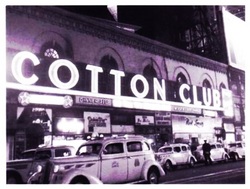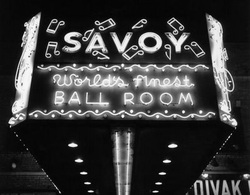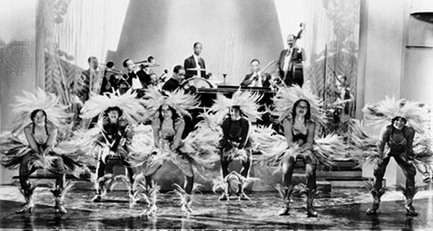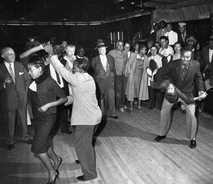Popular Entertainment
The Cotton Club

Nightclubs were an important way to show off African American talent during the REnaissance. The Cotton Club, happened to be one of these hotspots. It was located between 142nd street, and Lenox avenue. In 1923, Owney Madden, a white gangster opened the club. It was during the years of prohibition, so guests smuggled alcohol, illegally into the club. They could order a number of dishes, such as fried chicken and barbecued ribs, while enjoying numerous forms of entertainment, such as the Cotton Club's chorus line. The acts featured all African Americans, such as singers like Ethel Waters (click to watch Ethel Waters, I've Found a New Baby). Dancers, like Clayton "Peg Leg" Bates performed; Bates demonstrated incredible skill, dancing on literally, one leg (see below). Some really famous names, such as Duke Ellington and Cab Calloway (click to see Cab Calloway and his Band perform at the Cotton Club) performed there, with their bands, as well. Though all the acts were performed by African Americans, whites were the only ones originally admitted into the Cotton Club as guests. However, Duke Ellington was eventually able to persuade the club to allow African Americans to be admitted. They eventually filled up the seats in the back of the club. Regardless, the Cotton Club helped exhibit black talent, and celebrate black culture during the Renaissance, and helped to make names such as Duke Ellington, unforgettable.
Carl Van Vechten and His Parties
Clubs were not the only source of popular entertainment during the renaissance. Carl Van Vechten had very large parties, with his wife, Fania Marinoff, in their New York City apartment. They made a point of inviting guests of all races to "break down the color bar". These parties created opportunities for many African Americans. Writers and performers went, and then met editors, producers, and publishers. Some party guests included Bessie Smith (see below) and Langston Hughes.
The Savoy Ballroom

This ballroom, which opened in March, 1926, was an exciting place to be during the night time in Harlem. it offered 12 consecutive hours of dancing every single day. Entrance fees were 50 cents, or 75 on the weekends. Dances such as the "Lindy Hop" or the "Shim Sham" were danced, and the music of great jazz artists was played, including Fletcher Henderson, and Joe "King" Oliver. Both whites and blacks were admitted to the Savoy Ballroom.




